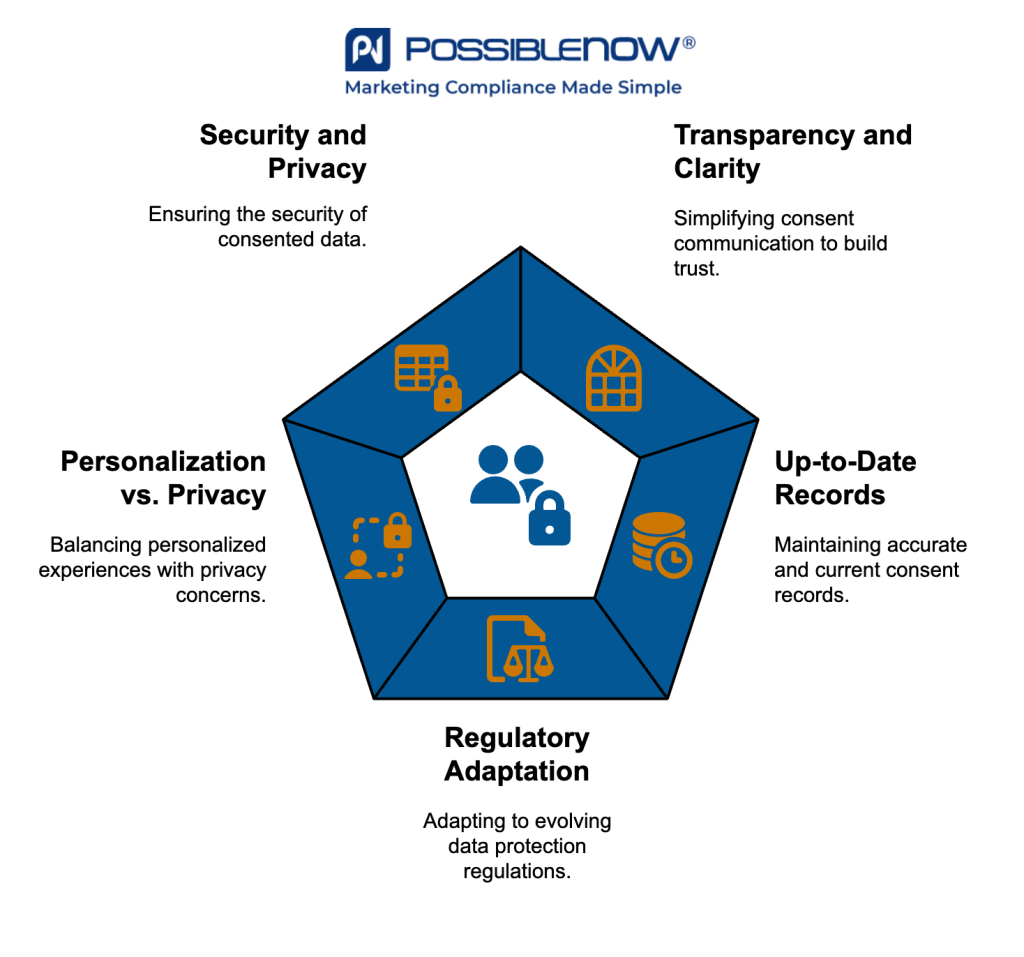Resource Center
Consent Management Challenges & How to Overcome Them
Type: Blog
Topic: Consent Mgmt

In the era of digital transformation, where customer data plays a critical role in personalized marketing and service delivery, managing customer consent has emerged as a significant challenge for organizations. Effective consent management ensures that a company respects customer preferences and complies with global data protection regulations like GDPR, CCPA, and others. However, navigating the complexities of consent management presents several challenges. This blog post explores common obstacles organizations face in this area and offers strategies for overcoming them.
Getting Started is Just a Call Away
Challenge 1: Ensuring Transparency and Clarity
The Challenge: Many organizations struggle to communicate their data collection and usage practices in a transparent and understandable manner. Legal jargon and complex consent forms can confuse customers, leading to a lack of trust and engagement.
The Solution: Simplify consent requests by using clear, straightforward language. Explain why you’re collecting data, how it will be used, and the benefits to the customer. Tools like consent management platforms (CMPs) can help standardize and simplify the presentation of consent forms across digital touchpoints.
Challenge 2: Maintaining Up-to-Date Consent Records
The Challenge: Keeping accurate and current records of customer consents is a logistical nightmare for many organizations, especially those operating on a large scale or across multiple platforms.
The Solution: Implement robust data management systems that can track consent status in real time across all customer touchpoints. An efficient CMP can manage this with ease. Automating consent updates can help ensure that records are always current, reducing legal risks and enhancing customer trust.
Challenge 3: Adapting to Changing Regulations
The Challenge: Data protection laws are continually evolving, and what’s compliant today may not be tomorrow. Keeping up with these changes and ensuring ongoing compliance can be daunting.
The Solution: Stay informed about regulatory changes by subscribing to legal updates and engaging with data protection authorities. Consider appointing a data protection officer (DPO) responsible for understanding regulations and implementing necessary changes. Regular audits and reviews of consent management practices can also help maintain compliance.
Challenge 4: Balancing Personalization with Privacy
The Challenge: Customers demand personalized experiences but are increasingly concerned about privacy. Finding the right balance between using data for personalization and respecting customer consent is challenging.
The Solution: Leverage zero-party and first-party data, where consent is explicit, to drive personalization. Be transparent about the benefits of data sharing for personalization to encourage consent. Additionally, invest in platforms like MyPreferences that enable personalization within the boundaries of consented data use.
Challenge 5: Managing Consent Across Multiple Channels
The Challenge: Customers interact with brands through various channels, each requiring its consent management approach. Consistently managing consent across these channels can be complex.
The Solution: Adopt a centralized consent management platform like MyPreferences that integrates with all customer touchpoints, ensuring a unified approach to consent across the organization. This not only simplifies management but also provides a consistent experience for customers.
Challenge 6: Ensuring Security and Privacy
The Challenge: Protecting the privacy and security of consented data is paramount. Any breach can lead to significant legal, financial, and reputational damage.
The Solution: Implement stringent security measures, including encryption, access controls, and regular security audits. Educate employees about data protection and establish clear policies and procedures for handling customer data.
Conclusion

Managing customer consent effectively is essential for building trust, ensuring compliance, and delivering personalized customer experiences. By addressing challenges such as ensuring transparency, maintaining up-to-date records, adapting to changing regulations, balancing personalization with privacy, managing consent across multiple channels, and ensuring data security, organizations can navigate the complexities of consent management. Adopting the right strategies and technologies will not only help overcome these challenges but also turn consent management into a competitive advantage, fostering stronger customer relationships and driving business success.
About PossibleNOW
PossibleNOW is the pioneer and leader in customer consent, preference, and regulatory compliance solutions. We leverage our MyPreferences technology, processes, and services to enable relevant, trusted, and compliant customer interactions. Our platform empowers the collection, centralization, and distribution of customer communication consent and preferences across the
enterprise. DNCSolution addresses Do Not Contact regulations such as TCPA, CAN-SPAM and CASL, allowing companies to adhere to DNC requirements, backed by our 100% compliance guarantee.
PossibleNOW’s strategic consultants take a holistic approach, leveraging years of experience when creating strategic roadmaps, planning technology deployments, and designing customer interfaces. PossibleNOW is purpose-built to help large, complex organizations improve customer experiences and loyalty while mitigating compliance risk.
Request a Demo Today
-
TCPA Regulations and Compliance: Complete Guide
Type: Blog
Topic: Do Not Call Solution
-
Defining Meaningful Metrics: 6 Soft KPIs to Measure Customer Preference Collection
Type: Blog
Topic: Preference Mgmt
-
Email Preference Center Best Practices
Type: Blog
Topic: Preference Mgmt
-
The Basics of DNC Scrubbing: What Is a Do Not Call (DNC) Scrubber and Why Do You Need It?
Type: Blog
Topic: Do Not Call Solution
-
What is Consent Management, How it Works, & Why it’s Important for Data Compliance
Type: Blog
Topic: Consent Mgmt
-
Do Insurance Companies Cover TCPA Damages?
Type: Blog
Topic: Do Not Call Solution
-
8 Best Practices for Capturing GDPR Consent
Type: Webinars
-
Data Silos Cause Communication Gaps
Type: Videos
Topic: Preference Mgmt
-
Difference Between Preferences & Consent
Type: Videos
Topic: Preference Mgmt
-
Integrate Do Not Call Compliance with Preferences
Type: Videos
Topic: Preference Mgmt
-
Customer Preferences Require More Than One Flavor
Type: Videos
Topic: Preference Mgmt
-
Give Customers Opt-Down Options
Type: Videos
Topic: Preference Mgmt
-
Preference Center Organization
Type: Videos
Topic: Preference Mgmt
-
Strategic Consultants Benefited Scotiabank
Type: Videos
Topic: Industry Testimonials
-
How to Check If a Number Is on the Do Not Call Registry
Type: Blog
Topic: Do Not Call Solution
-
Building a Customer-Centric DNC Strategy
Type: Blog
Topic: Do Not Call Solution
-
Best Tools for Managing Do Not Contact Lists
Type: Blog
Topic: Do Not Call Solution
